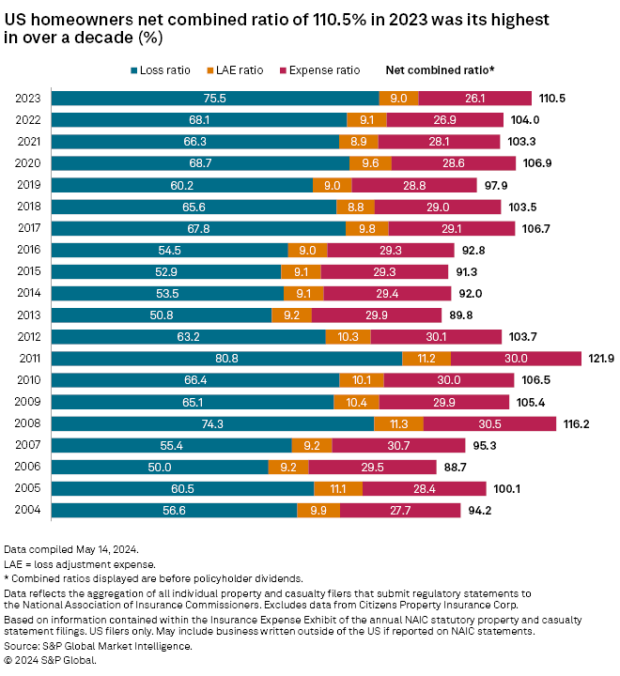The U.S. homeowners insurance segment posted its worst underwriting results in over a decade in 2023, according to an analysis by S&P Global Market Intelligence.
The net combined ratio for the homeowners business, excluding policyholders’ dividends, was 110.5 in 2023, the highest since 2011 (121.9).
S&P said inflationary pressures, the devastating wildfire in Hawaii and a record-breaking number of billion-dollar loss events from convective storms weighed on the industry’s results.
Despite boosting rates across the U.S., homeowners insurers saw net underwriting losses of about $15 billion in 2023, compared to $5.89 billion during the previous year, excluding state-backed insurers of last resort.
U.S. homeowners insurers saw their net losses and loss adjustments expenses jump to $101.29 billion in 2023, a year-over-year increase of 21.3 percent, while net premiums earned only grew by 10.8 percent to $119.89 billion. Other underwriting expenses equaled $33.36 billion during the year compared to $30.59 billion during 2022, according to the analysis.
Among the 20 largest U.S. homeowners insurers, only Chubb Ltd. and Amica Mutual Insurance Co. saw combined ratios under 100 in 2023. Chubb’s net combined ratio was 89.6 in 2023, while Amica posted a combined ratio of 97.4.
Florida’s Citizens Property Insurance Corp. became one of the 10 largest U.S. homeowners underwriters in 2023, knocking Progressive into the No. 11 spot. Citizens reported direct premiums written of $3.21 billion—up a whopping 42.2 percent year-over-year.
In aggregate, the property and casualty homeowners industry recorded $152.51 billion in direct premiums written during the most recent year compared to $133.79 billion in 2022.
See the full S&P Global Market Intelligence report for more information.






















 Artificial Intelligence Is Rewriting the Rules for Commercial Lines
Artificial Intelligence Is Rewriting the Rules for Commercial Lines  Why the Middle Market Matters and How Insurers Can Capture It
Why the Middle Market Matters and How Insurers Can Capture It  Executives on the Move at Liberty Mutual, Cowbell, W. R. Berkley
Executives on the Move at Liberty Mutual, Cowbell, W. R. Berkley  Breaking: Andersen to Replace Zaffino as CEO of AIG on June 1
Breaking: Andersen to Replace Zaffino as CEO of AIG on June 1 




